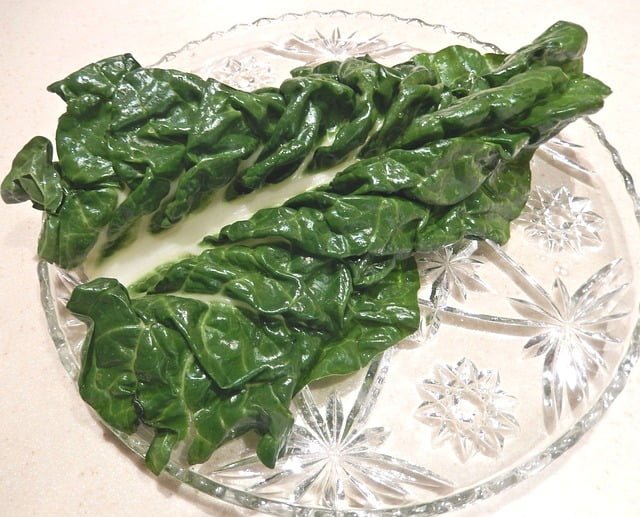Let’s go through the process of dehydrating Swiss Chard, learn about its nutritional benefits, and provide helpful advice for storing and using it.
Understanding Dehydration
Dehydration is a preservation method that removes the water content from food. This process inhibits the growth of bacteria, yeast, and mold, which results in a longer shelf life for the food item.
When it comes to Swiss Chard, dehydration allows you to enjoy this nutrient-rich leafy green throughout the year. It also makes it more portable and less bulky, making it easier to store or even carry on camping trips.
The Need for Blanching
Before we get started with the dehydration process, it’s crucial to understand the importance of blanching. Swiss Chard, like other leafy greens, contains oxalates. These are naturally occurring compounds that, when consumed in large quantities, can lead to the formation of kidney stones.
Blanching the vegetable in boiling water for a minute can help reduce its oxalic acid content. Following blanching, it’s essential to immerse the Swiss Chard in ice water immediately. This step, known as ‘shocking,’ halts the cooking process, preserving the Swiss Chard’s vibrant color and fresh flavor.
Method 1: Dehydrating Swiss Chard Using a Food Dehydrator
Dehydrating Swiss Chard using a food dehydrator is a straightforward process. Follow these steps:
- Begin by selecting fresh and undamaged Swiss Chard leaves.
- Rinse the leaves thoroughly under cold running water.
- Pat the leaves dry using a clean towel.
- Remove the thick stems and center ribs, as these parts are juicier and increase the drying time. If you want, you can dehydrate them separately or use them in soups or stews.
- Cut the leaves into 4-inch pieces using a sharp knife.
- Blanch the leaves in boiling water for one minute, then immerse them in ice water to stop the cooking process.
- Dry the blanched leaves using paper towels to remove excess water.
- Lay out the leaves on the dehydrator trays, making sure they do not overlap and there is enough space for air circulation.
- Set the dehydrator at 135 °F and let the vegetable dry for 2-3 hours until they turn crispy.
- Once dried, let the leaves cool down to room temperature, then store them in an airtight container for later use.
Method 2: Dehydrating Swiss Chard in an Oven
If you do not have a food dehydrator, you can use your oven to dehydrate Swiss Chard. The preparation process remains the same as the previous method. Here’s how to do it:
- Preheat your oven to the lowest heat setting, around 120°F.
- Place the prepared leafy vegetable in a single layer on a cookie sheet lined with parchment paper.
- Bake the vegetable Chard for about 2-3 hours. You can keep the oven door slightly ajar for better air circulation.
- Check the leaves every hour to monitor their dryness. The Swiss Chard is fully dehydrated when it crumbles easily.
- Once dried, cool the leaves at room temperature before storing them in an airtight container.
Method 3: Sun-Drying Swiss Chard
If you live in an area with regular warm, sunny days, you can try the traditional method of sun-drying Swiss Chard. However, this method is not recommended for regions with cold or rainy climates.
To sun-dry Swiss Chard:
- After preparing the Swiss Chard as mentioned in previous methods, string the leaves together with parts of the stems still attached.
- Use a knife to slit the stems and insert twine so you can hang the leaves.
- Hang the strung leaves in a sunny area and let nature do its work. Depending on the weather, it could take a couple of days for the leafy vegetable to dry completely.
- Once dry, store the food in airtight containers.
Storing Dehydrated Swiss Chard
Proper storage of dehydrated Swiss Chard can significantly extend its shelf life. After cooling the dried Swiss Chard at room temperature, pack it in sealed, airtight containers. Glass containers are preferable as they prevent any potential chemical reaction with the food.
Store these containers in a cool, dark place to prevent the dried vegetable from spoiling. The refrigerator or freezer can also be used for storing this dried food to help retain its quality. If you want to achieve optimum quality, keep the Swiss Chard in the freezer, constantly frozen.
Take care to avoid storing dehydrated Swiss Chard in a humid, hot room, as it could still spoil despite being packed in sealed containers. When you’re ready to use the dehydrated Swiss Chard, rehydrate it by soaking it in warm water for a few minutes.
Before using, always inspect your dried Swiss Chard to ensure it’s still good. If they appear off or smell bad, or if you notice any mold, discard them immediately.
The Health Benefits of Dehydrated Swiss Chard
Swiss Chard is known for its numerous health benefits, and dehydrating it preserves most of its nutritional content. Here are some reasons to include dehydrated Swiss Chard in your diet:
- Swiss Chard is rich in Vitamin K, which improves bone strength and overall bone health.
- The vegetable is a generous source of antioxidants that help prevent various liver ailments.
- Regular consumption of Swiss Chard can help maintain normal blood pressure levels or lower high blood pressure.
- Swiss Chard contains phenolic compounds known to fight and destroy cancer cells.
- The vegetable may have potential cognitive benefits, although more research is needed to confirm this.
- Swiss Chard is rich in biotin, which significantly improves skin health.
- The vegetable supports eye health, protecting your eyes from various diseases.
- Regular consumption of Swiss Chard is good for heart health, thanks to its potassium content.
- Swiss Chard is a good source of iron, which can help prevent anemia.
By dehydrating Swiss Chard, you can ensure a ready supply of this nutrient-rich vegetable anytime you need it.
FAQ
What greens are good to dehydrate?
Favorite green ingredients suited for dehydration are. Kale, Swiss Chard, Spinach, Bok Choy, Arugula, Parsley, Cilantro.
What are the side effects of Swiss Chard?
Is Swiss Chard good for eating? Although Swiss Chards are highly healthy, the food should be consumed with caution. Eating too much is associated with a decrease in the body’s calcium absorption, which can cause kidney stones.
Conclusion
Dehydrating Swiss Chard is a practical way to enjoy this nutritious leafy green all year round. Whether you use a food dehydrator, an oven, or the natural heat of the sun, you can easily preserve Swiss Chard at home. Plus, it’s a fantastic way to reduce waste if you find yourself with more Swiss Chard than you can use at once. With proper storage, you can keep dehydrated Swiss Chard for up to a year, making it a valuable addition to your pantry. So, go ahead, give it a try, and boost the nutritional value of your meals with dehydrated Swiss Chard!

